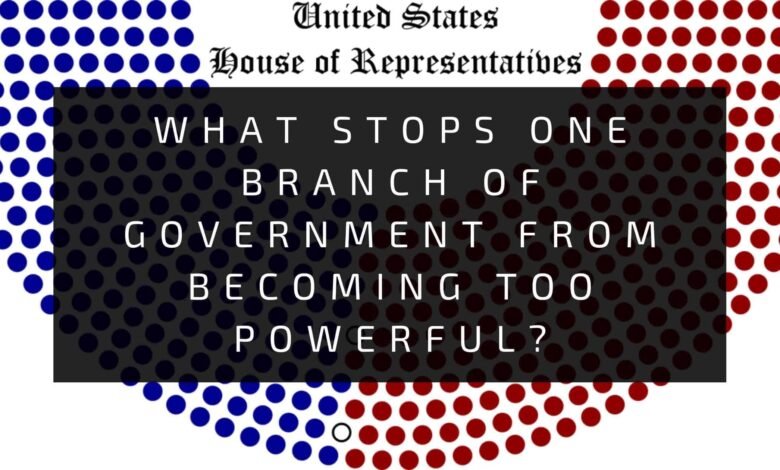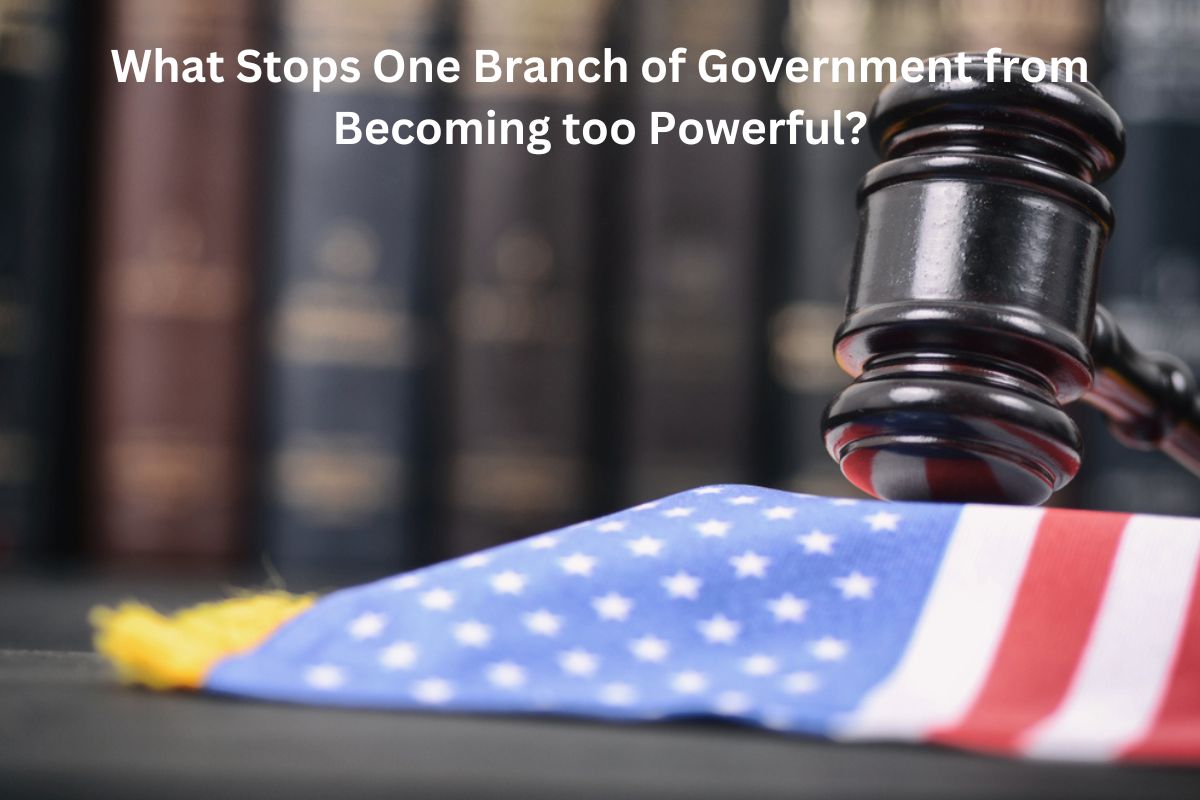What Stops One Branch Of Government From Becoming Too Powerful: Checks and Balances

Checks and balances stop one branch of government from becoming too powerful. This system ensures that power is distributed evenly among the three branches: executive, legislative, and judicial.
In democratic nations, the concept of checks and balances is crucial. It prevents any one branch from gaining too much control. This system fosters cooperation and accountability. The executive branch enforces laws, the legislative makes laws, and the judicial interprets laws.
This separation of powers ensures that each branch can limit the others. By doing so, it protects citizens’ freedoms and maintains a fair government. Understanding checks and balances helps us appreciate the stability and fairness in our government structure. Let’s explore how each branch functions to keep this balance intact.
Historical Background
The balance of power between branches of government is a cornerstone of democracy. It ensures that no single branch becomes too powerful. This idea has deep historical roots.
Origins Of Checks And Balances
The concept of checks and balances comes from ancient times. The Roman Republic had a system where different branches shared power. This idea influenced many modern democracies.
In the 18th century, the framers of the U.S. Constitution adopted checks and balances. They wanted to prevent any branch from gaining too much power. They believed this system would protect individual freedoms.
Influence Of Enlightenment Thinkers
Enlightenment thinkers like Montesquieu shaped the idea of checks and balances. Montesquieu argued for a separation of powers in his book “The Spirit of the Laws.” He believed that dividing power was key to freedom.
John Locke also influenced this idea. He wrote about the need for separate branches of government. He believed it would prevent tyranny. These thinkers’ ideas were crucial in forming modern democratic systems.
Legislative Branch Controls
The Legislative Branch of the government holds significant power. But various controls keep it in check. These controls ensure no branch becomes too powerful. Let’s explore the key controls within the Legislative Branch.
Power To Make Laws
The Legislative Branch has the power to make laws. This power is vital for any functioning democracy. Elected representatives propose, debate, and vote on laws. This process involves multiple steps, ensuring thorough examination. Each law requires approval from both houses of Congress. This system prevents hasty decisions and promotes careful consideration.
Oversight And Investigation
The Legislative Branch also performs oversight and investigation. Congress has committees dedicated to overseeing government operations. These committees investigate potential abuses of power. They hold hearings and call witnesses to testify. This ensures accountability within the government.
| Control Mechanism | Description |
|---|---|
| Power to Make Laws | Legislative process involves multiple steps and approvals. |
| Oversight and Investigation | Committees investigate and ensure accountability. |
These controls are essential for a balanced government. They ensure no branch becomes too powerful.
Executive Branch Limits
The Executive Branch of the United States government holds significant power. Yet, this power is not absolute. Various mechanisms ensure that the Executive Branch does not become too powerful. These mechanisms include the Presidential Veto and Appointment Powers.
Presidential Veto
The Presidential Veto is a critical check on legislative power. The President can reject a bill passed by Congress. This rejection prevents the bill from becoming law. Congress can override the veto with a two-thirds vote in both houses. This process ensures that the President cannot unilaterally block legislation.
| Action | Outcome |
|---|---|
| Bill passed by Congress | Sent to President |
| President vetoes bill | Bill returns to Congress |
| Congress overrides veto | Bill becomes law |
| Congress fails to override veto | Bill does not become law |
Appointment Powers
The President has the power to appoint key officials. These include judges, ambassadors, and cabinet members. This power is checked by the Senate. The Senate must confirm these appointments. This confirmation process ensures that appointees are suitable for their roles.
- President nominates a candidate.
- Senate holds hearings on the nominee.
- Senate votes to confirm or reject the nominee.
This system prevents the President from appointing unqualified individuals. It also ensures that appointments reflect the broader interests of the government.

Credit: www.havefunwithhistory.com
Judicial Branch Safeguards
The Judicial Branch plays a vital role in preventing any single branch of government from becoming too powerful. It has unique safeguards that ensure a balanced and fair government. These safeguards include Judicial Review and Lifetime Tenure. Let’s explore these crucial elements in detail.
Judicial Review
Judicial Review allows courts to assess the constitutionality of laws and government actions. This power ensures that laws align with the Constitution. If a law violates the Constitution, the courts can strike it down. This process keeps the legislative and executive branches in check.
By reviewing laws, the Judicial Branch prevents abuses of power. It ensures that no law can undermine the rights and freedoms of citizens. This safeguard maintains the balance of power within the government.
Lifetime Tenure
Lifetime Tenure for judges is another critical safeguard. Judges, once appointed, serve for life or until they choose to retire. This tenure protects judges from political pressures. They can make decisions based on law and justice, not on popular opinion or political influence.
This independence allows judges to uphold the Constitution without fear of losing their positions. It ensures that the Judicial Branch remains impartial and fair. It also prevents the other branches from exerting undue influence over the judiciary.
In summary, the Judicial Branch safeguards include Judicial Review and Lifetime Tenure. These mechanisms are essential for maintaining a balanced and fair government. They prevent any single branch from becoming too powerful.
Checks Between Branches
The U.S. government is designed to ensure no single branch becomes too powerful. This is achieved through a system of checks and balances. Each branch can limit the powers of the others. This maintains a balance and prevents tyranny.
Impeachment Process
Impeachment is a vital check on executive power. The House of Representatives can impeach a president. This means they accuse the president of wrongdoing. If the House impeaches, the Senate holds a trial. The Senate can remove the president from office if found guilty. This process ensures the president follows the law.
Budgetary Controls
Budgetary controls are another key check. Congress controls government spending. The president proposes a budget, but Congress must approve it. This means no money can be spent without Congress’s consent. If Congress disagrees with the president, they can refuse to fund certain programs. This power ensures no branch spends money unchecked.
Role Of The Constitution
The Constitution plays a crucial role in maintaining the balance of power. It ensures that no single branch of government becomes too powerful. This document lays the foundation for a system of checks and balances. Each branch has its own distinct powers and responsibilities.
Foundational Principles
The Constitution is built on key principles. These principles include separation of powers, checks and balances, and federalism.
Separation of powers divides the government into three branches:
- Legislative
- Executive
- Judicial
Checks and balances is a system that allows each branch to limit the powers of the other branches. For example, the President can veto laws passed by Congress. The Supreme Court can declare laws unconstitutional.
Federalism divides power between the national government and state governments. This ensures that power is not concentrated in one place.
Amendment Process
The Constitution can be amended to address new issues or correct problems. This process is intentionally difficult to ensure stability.
The amendment process involves two steps:
- Proposal
- Ratification
An amendment can be proposed by a two-thirds vote in both houses of Congress. Alternatively, a constitutional convention can be called by two-thirds of state legislatures.
Once proposed, an amendment must be ratified by three-fourths of state legislatures or state conventions. This rigorous process prevents hasty changes and ensures broad support.
This system of checks and balances and the amendment process work together to keep any one branch from becoming too powerful.
Modern Challenges
Modern challenges have made it harder to keep one branch of government from becoming too powerful. The changing political landscape and evolving legal interpretations are some key issues. These factors affect the balance of power in significant ways.
Partisan Politics
Partisan politics can create bias within government branches. When one party dominates, it often pushes its agenda. This can lead to an imbalance of power. Lawmakers may pass laws that favor their party’s interests. This can undermine checks and balances. The judicial branch may also be affected by partisan appointments. Judges may rule in ways that reflect their party’s views. This can weaken the impartiality of the courts.
Evolving Legal Interpretations
Legal interpretations change over time. Courts often reinterpret the Constitution. This can shift the balance of power. Some rulings expand the powers of one branch. Others may limit it. These changes can have lasting effects. They may alter how checks and balances work. Evolving legal interpretations can also create uncertainty. This makes it harder to predict how power will be distributed.

Credit: www.youtube.com
Case Studies
Case studies offer valuable insights into how the checks and balances system works. They reveal the mechanisms that stop one branch of government from becoming too powerful. By analyzing historical events, we can understand the importance of this balance.
Watergate Scandal
The Watergate Scandal serves as a prime example of executive overreach. President Nixon’s involvement in the break-in and cover-up led to a constitutional crisis. The legislative branch played a key role in uncovering the truth. Congress launched investigations, held hearings, and eventually, the House Judiciary Committee recommended impeachment. This scandal highlighted the power of congressional oversight. It proved that no one, not even the President, is above the law.
Judicial Appointments Controversies
Judicial appointments often spark controversy and debate. These disputes showcase the delicate balance of power between branches. For instance, the appointment of judges requires both executive nomination and Senate confirmation. This process ensures that no single branch has unilateral control over the judiciary. Controversial nominations, like those of Brett Kavanaugh and Merrick Garland, have tested this system. Heated debates and thorough vetting processes emphasize the importance of maintaining a balanced judiciary. These controversies remind us of the critical role checks and balances play in our government.

Credit: dcmp.org
Frequently Asked Questions
What Prevents One Branch Of Government From Dominating?
Checks and balances prevent any branch from becoming too powerful. Each branch can limit the powers of the others.
How Do Checks And Balances Work?
Checks and balances allow each branch to monitor and limit the others. This system ensures no single branch gains excessive power.
Why Are Checks And Balances Important?
Checks and balances are crucial for maintaining democracy. They prevent any single branch from overpowering the others.
What Is The Role Of Separation Of Powers?
Separation of powers divides government responsibilities among branches. This division helps prevent any branch from gaining too much control.
Conclusion
Each branch of government holds its unique powers. Checks and balances keep them in line. This system prevents any one branch from dominating. It ensures fairness and justice. Citizens benefit from this balanced structure. Understanding this concept strengthens our democracy.
Stay informed. Appreciate the balance.



